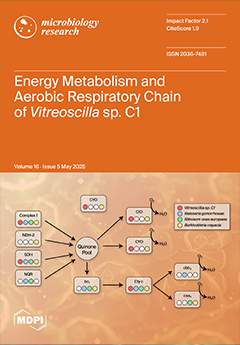Rhizosphere microorganisms effectively exploit nutrient resources within the rhizosphere, while growth-promoting bacteria in this environment play a vital role in regulating soil fertility and enhancing plant health. In this study, we utilized a comprehensive approach that included the isolation, purification, and identification of
[...] Read more.
Rhizosphere microorganisms effectively exploit nutrient resources within the rhizosphere, while growth-promoting bacteria in this environment play a vital role in regulating soil fertility and enhancing plant health. In this study, we utilized a comprehensive approach that included the isolation, purification, and identification of dominant microorganisms, alongside high-throughput sequencing technology. This methodology was employed to analyze the primary microbial groups and their diversity within the rhizosphere soil of
Helichrysum arenarium (L.) Moench in Altay, Xinjiang, China. By isolating bacterial strains from the rhizosphere soil using a dilution coating method, we successfully obtained 43 distinct strains. Subsequently, selective media were employed to screen for growth-promoting characteristics among these isolated strains derived from the rhizosphere soil of
H. arenarium (L.) Moench. The results, obtained through high-throughput amplification sequencing, revealed diverse bacterial communities belonging to 35 phyla, 93 orders, 215 families, 324 genera, and 231 species associated with
H. arenarium (L.) Moench, as well as fungal communities comprising 14 phyla, 47 orders, 96 families, 204 genera, and 571 species present in the rhizosphere soil. Among these identified communities, Actinobacteriota emerged as the predominant bacterial phylum while Ascomycetes and Mortieromycetes were recognized as the principal fungal phyla found in the rhizospheric soil of
H. arenarium (L.) Moench. Analysis of culturable bacteria’s promotion activity within this rhizospheric environment indicated that three strains—S16, S31, and S29—exhibited the highest solubility index for inorganic phosphorus; additionally, the screened strains S7 and S10 demonstrated nitrogen-fixing capabilities. Furthermore, ten strains exhibiting excellent iron-bearing capacities were identified; notably, strain S16 displayed the highest D/d value indicating, its superior iron-bearing capacity. The growth-promoting bacteria were identified as
Kocuria rosea,
Priestia megaterium,
Bacillus mobilis,
Bacillus bataviensis, three variants of
Bacillus mycoides,
Bacillus paramobilis,
Bacillus sonorensis, and
Alcaligenes faecalis. This study provides a foundational understanding of how microorganisms in the rhizosphere of
H. arenarium (L.) Moench influence soil nutrient release and offers valuable insights into enhancing yield and quality cultivation by isolating, screening, and identifying growth-promoting bacteria from rhizosphere soil.
Full article





